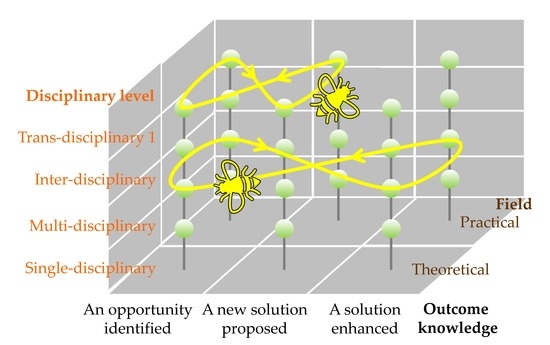Research Series Review for Transdisciplinarity Assessment—Validation with Sustainable Consumption and Production Research
Abstract
1. Introduction
- How can one capture a series of research works from scientific publications?
- What are relevant indicators to assess a series of research works from the TD perspective?
2. Method and Materials
2.1. Research Series Review (RSR)—the Proposed Method
2.2. Materials
3. Results
3.1. Overview
3.2. Genealogy for PSS Design Research
3.3. Genealogy for Robust Design Research
3.4. Analysis of Results from TD Research Perspective
3.4.1. Overview
- Field—This refers to the environment of research, practical or theoretical (laboratory or desktop). The practical environment can be further detailed in terms of the intensity of interaction between scientists and users. Note that this is not meant for practical or theoretical knowledge, which is more related to the first dimension.
- Disciplinary level—This denotes the level of disciplinarity and is single-, multi-, inter-, or trans-disciplinary 1 [7].
- Outcome knowledge—This dimension has three values: an opportunity identified, a new solution proposed, and a solution enhanced. The second and the third could be merged into one but are kept separate as a proposal to be able to emphasize the newness of a solution relative to extant literature.
3.4.2. Genealogy for PSS Design Research from TD Perspective
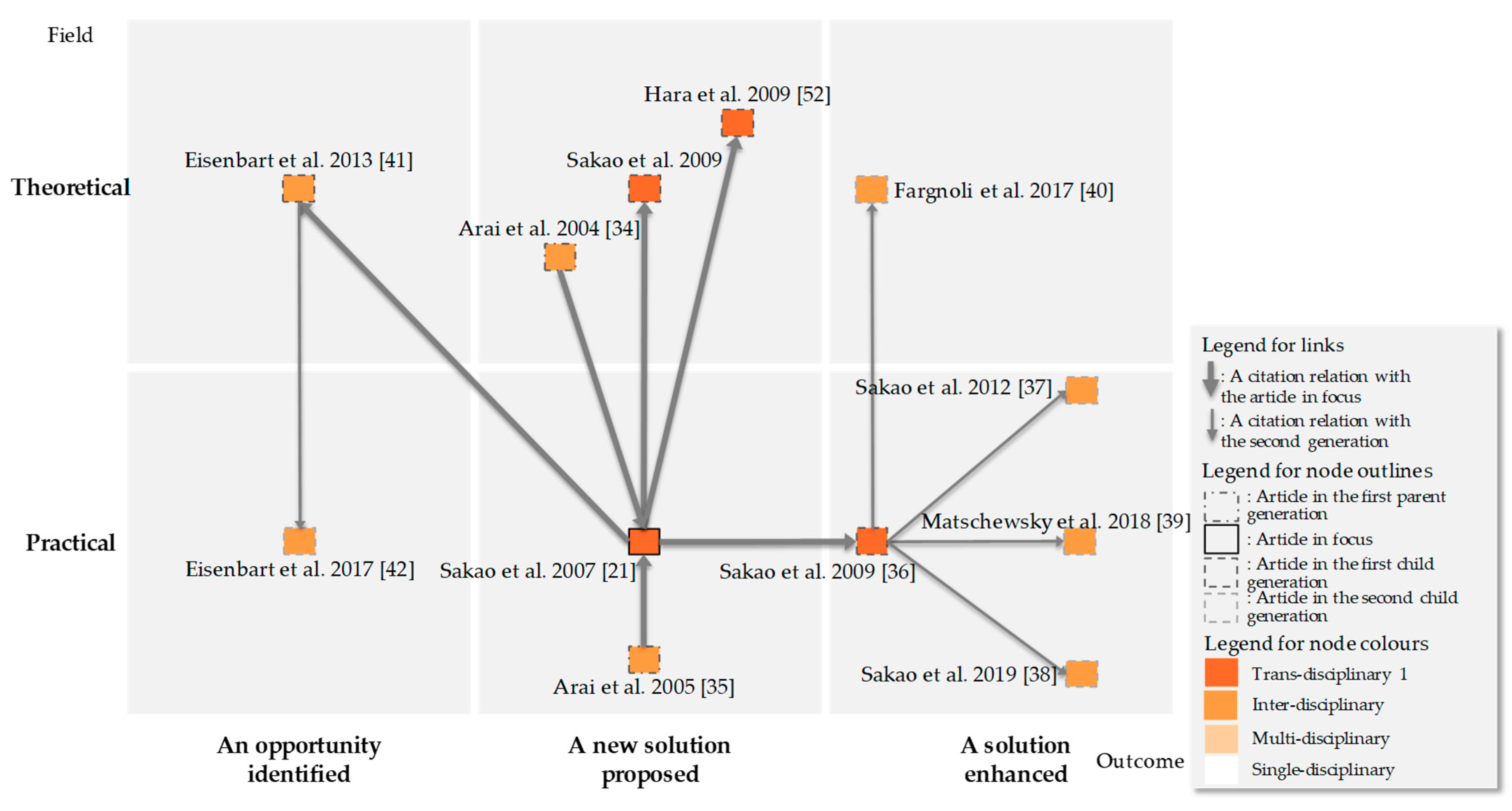
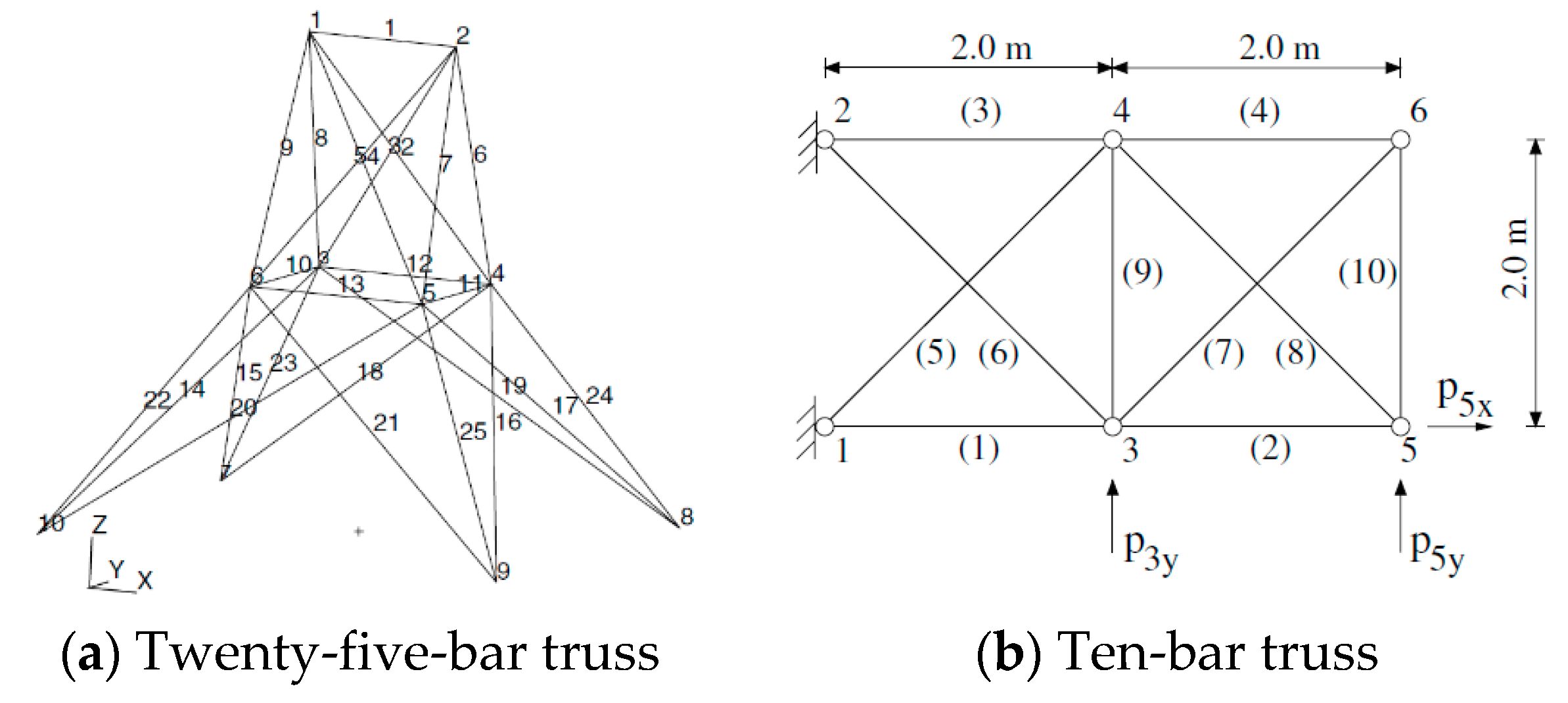
3.4.3. Genealogy for Robust Design Research from TD Perspective
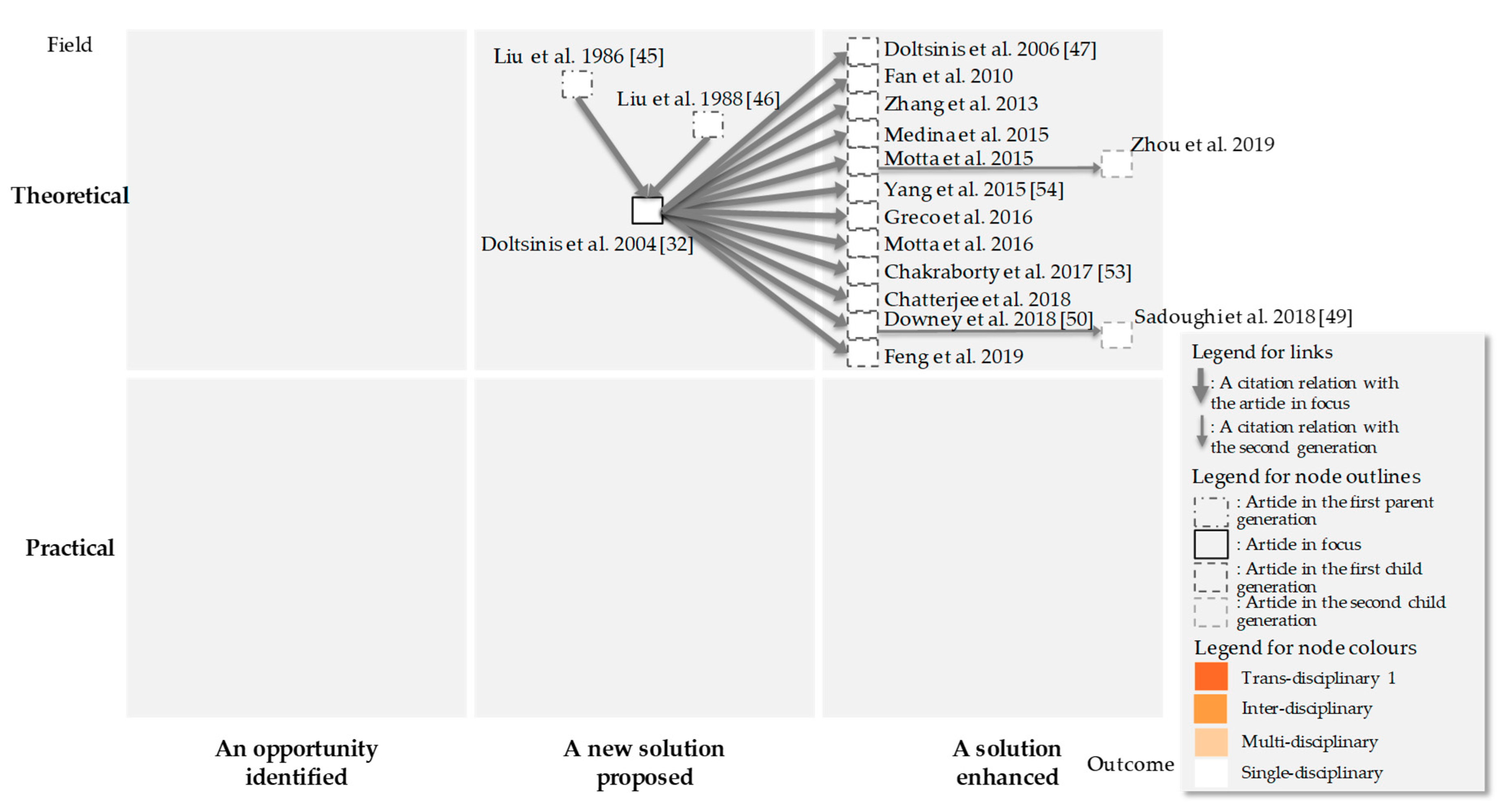
3.4.4. Analysis with Indicators
- Frequency of research in a practical field: (the number in the practical field)/(the number of population)
- Frequency of TD-1 research: (the number in TD-1) / (the number of population)
- Frequency of single discipline research: (the number in single-disciplinary)/(the number of population)
- Frequency of a solution provided: ((the number in a new solution proposed) + (the number in a solution enhanced))/(the number of population)
- Probability to switch fields: (the number of links connecting nodes in different fields)/(the number of all the links)
4. Discussion
4.1. Effectiveness of Research Series Review (RSR)
4.2. Implications for Research on SCP
4.3. Scientific Newness
5. Conclusions and Future Work
5.1. Conclusions
5.2. Future Work
5.2.1. Research Series Review (RSR)
5.2.2. Dimensions for Assessment from TD Research Perspective
Supplementary Materials
Author Contributions
Funding
Acknowledgments
Conflicts of Interest
Appendix A
| Document Title | Year | Source | Citation |
|---|---|---|---|
| A review of robust optimal design and its application in dynamics | 2005 | Computers and Structures | 247 |
| An integrated framework for optimization under uncertainty using inverse reliability strategy | 2004 | Journal of Mechanical Design | 218 |
| Robust design of structures using optimization methods [32] | 2004 | Computer Methods in Applied Mechanics and Engineering | 206 |
| Nano spray drying: A novel method for preparing protein nanoparticles for protein therapy | 2011 | International Journal of Pharmaceutics | 204 |
| Robust optimization considering tolerances of design variables | 2001 | Computers and Structures | 200 |
Appendix B
- List of covered journals for the PSS design research (the articles in these journals were all accessible and thus investigated when found in the database).
- List of covered journals for the robust design research (the articles in these journals were all accessible and thus investigated when found in the database).
Appendix C
| Generation | Label | Title | Source |
|---|---|---|---|
| P1 | Arai et al. 2004 [34] | Proposal of Service CAD System—A Tool for Service Engineering | CIRP Annals—Manufacturing Technology |
| P1 | Arai et al. 2005 [35] | Service CAD System—Evaluation and Quantification | CIRP Annals—Manufacturing Technology |
| Focus | Sakao et al. 2007 [21] | A Novel Engineering Discipline for Producers to Increase Value Combining Service and Product | Journal of Cleaner Production |
| C1 | Eisenbart et al. 2013 [41] | An Analysis of Functional Modeling Approaches Across Disciplines | Artificial Intelligence for Engineering Design, Analysis and Manufacturing |
| C1 | Hara et al. 2009 [52] | Service CAD System to Integrate Product Behavior and Service Activity for Total Value | CIRP Journal of Manufacturing Science & Technology |
| C1 | Sakao et al. 2009 [36] | An Effective and Efficient Method to Design Services: Empirical Study for Services by an Investment—Machine Manufacturer | International Journal of Internet Manufacturing and Services |
| C1 | Sakao et al. 2009 | Modeling Design Objects in CAD System for Service/Product Engineering | Computer-Aided Design |
| C2 | Sakao et al. 2012 [37] | A Value-Based Evaluation Method for Product/Service System Using Design Information | CIRP Annals—Manufacturing Technology |
| C2 | Eisenbart et al. 2017 [42] | Taking A Look at the Utilisation of Function Models in Interdisciplinary Design: Insights from 10 Engineering Companies | Research in Engineering Design |
| C2 | Fargnoli et al. 2017 [40] | Uncovering Differences and Similarities among Quality Function Deployment Based Methods in Design for X—Benchmarking in Different Domains | Quality Engineering |
| C2 | Matschewsky et al. 2018 [39] | Designing and Providing Integrated Productservice Systems—Challenges, Opportunities and Solutions Resulting from Prescriptive Approaches in 2 Industrial Companies | International Journal of Production Research |
| C2 | Sakao et al. 2019 [38] | A Methodological Approach for Manufacturers to Enhance Value-in-Use of Service-Based Offerings Considering 3 Dimensions of Sustainability | CIRP Annals—Manufacturing Technology |
| Generation | Label | Title | Source |
|---|---|---|---|
| P1 | Liu et al. 1986 [45] | A Random Field Finite Elements | International Journal for Numerical Methods in Engineering |
| P1 | Liu et al. 1988 [46] | Transient Probabilistic Systems | Computer Methods in Applied Mechanics and Engineering |
| Focus | Doltsinis et al. 2004 [32] | Robust Design of Structures Using Optimization Methods | Computer Methods in Applied Mechanics and Engineering |
| C1 | Doltsinis et al. 2006 [47] | Perturbation-Based Stochastic FE Analysis and Robust Design of Inelastic Deformation Processes | Computer Methods in Applied Mechanics and Engineering |
| C1 | Fan et al. 2010 | The Robust Optimization for Large-Scale Space Structures Subjected to Thermal Loadings | Journal of Thermal Stresses |
| C1 | Zhang et al. 2013 | Structural Reliability Analysis Based on the Concepts of Entropy, Fractional Moment and Dimensional Reduction Method | Structural Safety |
| C1 | Medina et al. 2015 | Probabilistic Measures for Assessing Appropriateness of Robust Design Optimization Solutions | Structural and Multidisciplinary Optimization |
| C1 | Motta et al. 2015 | Development of A Computational Efficient Tool for Robust Structural Optimization | Engineering Computations |
| C1 | Yang et al. 2015 [54] | Robust Design Optimization of Supporting Structure of Offshore Wind Turbine | Journal of Marine Science and Technology |
| C1 | Greco et al. 2016 | Robust Optimization of Base Isolation Devices under Uncertain Parameters | JVC/Journal of Vibration and Control |
| C1 | Motta et al. 2016 | An Efficient Procedure for Structural Reliability-Based Robust Design Optimization | Structural and Multidisciplinary Optimization |
| C1 | Chakraborty et al. 2017 [53] | A Surrogate Based Multi-Fidelity Approach for Robust Design Optimization | Applied Mathematical Modelling |
| C1 | Chatterjee et al. 2018 | Analytical Moment-Based Approximation for Robust DDesign Optimization | Structural and Multidisciplinary Optimization |
| C1 | Downey et al. 2018 [50] | Optimal Sensor Placement within A Hybrid Dense Sensor Network using An Adaptive Genetic Algorithm with Learning Gene Pool | Structural Health Monitoring |
| C1 | Feng et al. 2019 | An Innovative Estimation of Failure Probability Function Based on Conditional Probability of Parameter Interval and Augmented Failure Probability | Mechanical Systems and Signal Processing |
| C2 | Sadoughi et al. 2018 [49] | Reconstruction of Unidirectional Strain Maps Via Iterative Signal Fusion for Mesoscale Structures Monitored by A Sensing Skin | Mechanical Systems and Signal Processing |
| C2 | Zhou et al. 2019 | An Expanded Sparse Bayesian Learning Method for Polynomial Chaos Expansion | Mechanical Systems and Signal Processing |
References
- UNEP. Sustainable Consumption and Production—A Handbook for Policymakers; UNEP: Paris, France, 2015. [Google Scholar]
- Webster, K. The Circular Economy: A Wealth of Flows; Ellen MacArthur Foundation: Isle of Wight, UK, 2015. [Google Scholar]
- Luskin, J.; Blackman, A.B. Special issue—Sustainable Production and Consumption—Making the Connection. J. Clean. Prod. 2007, 15, 489–491. [Google Scholar] [CrossRef]
- Tukker, A.; Cohen, M.J.; Hubacek, K.; Mont, O. Sustainable Consumption and Production. J. Ind. Ecol. 2010, 14, 1–3. [Google Scholar] [CrossRef]
- Lettenmeier, M.; Liedtke, C.; Rohn, H. Eight Tons of Material Footprint—Suggestion for a Resource Cap for Household Consumption in Finland. Resources 2014, 3, 488–515. [Google Scholar] [CrossRef]
- von Wehrden, H.; Luederitz, C.; Leventon, J.; Russell, S. Methodological Challenges in Sustainability Science: A Call for Method Plurality, Procedural Rigor and Longitudinal Research. Chall. Sustain. 2017, 5, 35–42. [Google Scholar] [CrossRef]
- Sakao, T.; Brambila-Macias, S.A. Do we share an understanding of transdisciplinarity in environmental sustainability research? J. Clean. Prod. 2018, 170, 1399–1403. [Google Scholar] [CrossRef]
- McNie, E.C.; Parris, A.; Sarewitz, D. Improving the public value of science: A typology to informdiscussion, design and implementation of research. Res. Policy 2016, 45, 884–895. [Google Scholar] [CrossRef]
- Rosenfield, P. The potential of transdisciplinary research for sustaining and extending linkages between the health and social sciences. Soc. Sci. Med. 1992, 35, 1343–1357. [Google Scholar] [CrossRef]
- Lang, D.J.; Wiek, A.; Bergmann, M.; Stauffacher, M.; Martens, P.; Moll, P.; Swilling, M.; Thomas, C.J. Transdisciplinary research in sustainability science: Practice, principles, and challenges. Sustain. Sci. 2012, 7, 25–43. [Google Scholar] [CrossRef]
- Binder, C.R.; Absenger-Helmli, I.; Schilling, T. The reality of transdisciplinarity: A framework-based self-reflection from science and practice leaders. Sustain. Sci. 2015, 10, 545–562. [Google Scholar] [CrossRef]
- Turner II, B.; Esler, K.J.; Bridgewater, P.; Tewksbury, J.; Sitas, N.; Abrahams, B.; Chapin, F.S.; Chowdhury, R.R.; Christie, P.; Diaz, S.; et al. Socio-Environmental Systems (SES) Research: What have we learned and how can we use this information in future research programs. Curr. Opin. Environ. Sustain. 2016, 19, 160–168. [Google Scholar] [CrossRef]
- Schröder, P.; Vergragt, P.; Brown, H.S.; Dendler, L.; Gorenflo, N.; Matus, K.; Quist, J.; Rupprecht, C.D.D.; Tukker, A.; Wennersten, R. Advancing sustainable consumption and production in cities—A transdisciplinary research and stakeholder engagement framework to address consumption-based emissions and impacts. J. Clean. Prod. 2019, 213, 114–125. [Google Scholar] [CrossRef]
- de Oliveira, T.M.; Amaral, L.; dos Santos Pacheco, R.C. Multi/inter/transdisciplinary assessment: A systemic framework proposal to evaluate graduate courses and research teams. Res. Eval. 2019, 28, 23–36. [Google Scholar] [CrossRef]
- Wolf, B.; Lindenthal, T.; Szerencsits, M. Evaluating Research beyond Scientific Impact—How to Include Criteria for Productive Interactions and Impact on Practice and Society. GAIA 2013, 22, 104–114. [Google Scholar] [CrossRef]
- Zscheischler, J.; Rogga, S.; Lange, A. The success of transdisciplinary research for sustainable land use: Individual perceptions and assessments. Sustain. Sci. 2018, 13, 1061–1074. [Google Scholar] [CrossRef] [PubMed]
- Hoffmann, S.; Pohl, C.; Hering, J.G. Exploring transdisciplinary integration within a large research program: Empirical lessons from four thematic synthesis processes. Res. Policy 2017, 46, 678–692. [Google Scholar]
- Tranfield, D.; Denyer, D.; Smart, P. Towards a methodology for developing evidence-informed management knowledge by means of systematic review. Br. J. Manag. 2003, 14, 207–222. [Google Scholar] [CrossRef]
- Sun, F.; Zhu, L. Citation genetic genealogy: A novel insight for citation analysis in scientific literature. Scientometrics 2012, 91, 577–589. [Google Scholar] [CrossRef]
- Zhang, G.; Ding, Y.; Milojevic, S. Citation Content Analysis (CCA): A Framework for Syntactic and Semantic Analysis of Citation Content. J. Am. Soc. Inf. Sci. Technol. 2013, 64, 1490–1503. [Google Scholar] [CrossRef]
- Sakao, T.; Shimomura, Y. Service Engineering: A Novel Engineering Discipline for Producers to Increase Value Combining Service and Product. J. Clean. Prod. 2007, 15, 590–604. [Google Scholar]
- Mitev, N.; Venters, W. Reflexive Evaluation of an Academic-Industry Research Collaboration: Can Mode 2 Management Research be Achieved? J. Manag. Stud. 2009, 46, 733–754. [Google Scholar] [CrossRef]
- Mont, O.K. Clarifying the concept of product–service system. J. Clean. Prod. 2002, 10, 237–245. [Google Scholar] [CrossRef]
- Tukker, A. Product services for a resource-efficient and circular economy—A review. J. Clean. Prod. 2015, 97, 76–91. [Google Scholar] [CrossRef]
- Brambila-Macias, S.; Sakao, T.; Kowalkowski, C. Bridging the Gap between Engineering Design and Marketing: Insights for Research and Practice in Product/Service System Design. Des. Sci. 2018, 4. [Google Scholar] [CrossRef]
- Vezzoli, C.; Ceschin, F.; Diehl, J.C.; Kohtala, C. New design challenges to widely implement ‘Sustainable Product–Service Systems’. J. Clean. Prod. 2015, 97, 1–12. [Google Scholar] [CrossRef]
- Matschewsky, J. Unintended Circularity?—Assessing a Product-Service System for its Potential Contribution to a Circular Economy. Sustainability 2019, 11, 2725. [Google Scholar] [CrossRef]
- Pieroni, M.P.P.; McAloone, T.C.; Pigosso, D.C.A. Configuring New Business Models for Circular Economy through Product–Service Systems. Sustainability 2019, 11, 3727. [Google Scholar] [CrossRef]
- Ebro, M.; Howard, T.J. Robust design principles for reducing variation in functional performance. J. Eng. Des. 2016, 27, 75–92. [Google Scholar] [CrossRef]
- Taguchi, G. Introduction to Quality Engineering: Designing Quality into Products and Processes; Kraus International Publications: White Plains, NY, USA, 1986. [Google Scholar]
- Murphy, T.E.; Tsui, K.-L.; Allen, J.K. A review of robust design methods for multiple responses. Res. Eng. Des. 2005, 16, 118–132. [Google Scholar] [CrossRef]
- Doltsinis, I.; Kang, Z. Robust design of structures using optimization methods. Comput. Methods Appl. Mech. Eng. 2004, 193, 2221–2237. [Google Scholar] [CrossRef]
- Sakao, T.; Lindahl, M. A method to improve integrated product service offerings based on life cycle costing. CIRP An. Manuf. Technol. 2015, 64, 33–36. [Google Scholar] [CrossRef]
- Arai, T.; Shimomura, Y. Proposal of Service CAD System -A Tool for Service Engineering-. CIRP An. Manuf. Technol. 2004, 53, 397–400. [Google Scholar] [CrossRef]
- Arai, T.; Shimomura, Y. Service CAD System—Evaluation and Quantification. CIRP An. Manuf. Technol. 2005, 54, 463–466. [Google Scholar] [CrossRef]
- Sakao, T.; Birkhofer, H.; Panshef, V.; Dörsam, E. An Effective and Efficient Method to Design Services: Empirical Study for Services by an Investment-machine Manufacturer. Int. J. Internet Manuf. Serv. 2009, 2, 95–110. [Google Scholar] [CrossRef]
- Sakao, T.; Lindahl, M. A value based evaluation method for Product/Service System using design information. CIRP An. Manuf. Technol. 2012, 61, 51–54. [Google Scholar] [CrossRef]
- Sakao, T.; Wasserbaur, R.; Mathieux, F. A methodological approach for manufacturers to enhance value-in-use of service-based offerings considering three dimensions of sustainability. CIRP An. Manuf. Technol. 2019, 68, 33–36. [Google Scholar] [CrossRef]
- Matschewsky, J.; Kambanou, M.L.; Sakao, T. Designing and providing integrated productservice systems -challenges, opportunities and solutions resulting from prescriptive approaches in two industrial companies. Int. J. Prod. Res. 2018, 56, 2150–2168. [Google Scholar] [CrossRef]
- Fargnoli, M.; Sakao, T. Uncovering differences and similarities among Quality Function Deployment based methods in Design for X-benchmarking in different domains. Qual. Eng. 2017, 29, 690–712. [Google Scholar] [CrossRef]
- Eisenbart, B.; Gericke, K.; Blessing, L.T.M. An analysis of functional modeling approaches across disciplines. Artif. Intell. Eng. Des. Anal. Manuf. 2013, 27, 281–289. [Google Scholar] [CrossRef]
- Eisenbart, B.; Gericke, K.; Blessing, L.T.M. Taking a look at the utilisation of function models in interdisciplinary design: Insights from ten engineering companies. Res. Eng. Des. 2017, 28, 299–331. [Google Scholar] [CrossRef]
- Hara, T.; Arai, T.; Shimomura, Y. A CAD system for service innovation: Integrated representation of function, service activity, and product behaviour. J. Eng. Des. 2009, 20, 367–388. [Google Scholar] [CrossRef]
- Sakao, T.; Napolitano, N.; Tronci, M.; Sundin, E.; Lindahl, M. How Are Product-Service Combined Offers Provided in Germany and Italy?—Analysis with Company Sizes and Countries. J. Syst. Sci. Syst. Eng. 2008, 17, 367–381. [Google Scholar] [CrossRef][Green Version]
- Liu, W.K.; Belytschko, T.; Mani, A. Random field finite elements. Int. J. Num. Methods Eng. 1986, 23, 1831–1845. [Google Scholar] [CrossRef]
- Liu, W.K.; Besterfield, G.; Belytschko, T. Transient probabilistic systems. Comp. Methods Appl. Mech. Eng. 1988, 67, 27–54. [Google Scholar] [CrossRef]
- Doltsinis, I.; Kang, Z. Perturbation-based stochastic FE analysis and robust design of inelastic deformation processes. Comp. Methods Appl. Mech. Eng. 2006, 195, 2231–2251. [Google Scholar] [CrossRef]
- Ladeveze, P.; Puel, G.; Romeuf, T. Lack of knowledge in structural model validation. Comp. Methods Appl. Mech. Eng. 2006, 195, 4697–4710. [Google Scholar] [CrossRef][Green Version]
- Sadoughi, M.; Downey, A.; Yan, J.; Hu, C.; Laflamme, S. Reconstruction of unidirectional strain maps via iterative signal fusion for mesoscale structures monitored by a sensing skin. Mech. Syst. Signal. Process. 2018, 112, 401–416. [Google Scholar] [CrossRef]
- Downey, A.; Hu, C.; Laflamme, S. Optimal sensor placement within a hybrid dense sensor network using an adaptive genetic algorithm with learning gene pool. Struct. Health Monitor. 2018, 17, 450–460. [Google Scholar] [CrossRef]
- Brink, E.; Wamsler, C.; Adolfsson, M.; Axelsson, M.; Beery, T.; Björn, H.; Bramryd, T.; Ekelund, N.; Jephson, T.; Narvelo, W.; et al. On the road to ‘research municipalities’: Analysing transdisciplinarity in municipal ecosystem services and adaptation planning. Sustain. Sci. 2018, 13, 765–784. [Google Scholar] [CrossRef]
- Hara, T.; Arai, T.; Shimomura, Y.; Sakao, T. Service CAD System to Integrate Product Behavior and Service Activity for Total Value. CIRP J. Manuf. Sci. Technol. 2009, 1, 262–271. [Google Scholar] [CrossRef]
- Chakraborty, S.; Chatterjee, T.; Chowdhury, R.; Adhikari, S. A surrogate based multi-fidelity approach for robust design optimization. Appl. Math. Modell. 2017, 47, 726–744. [Google Scholar] [CrossRef]
- Yang, H.; Zhu, Y. Robust design optimization of supporting structure of offshore wind turbine. J. Mar. Sci. Technol. 2015, 20, 689–702. [Google Scholar] [CrossRef]
- Guertler, M.R.; Michailidou, I.; Lindemann, U. How to assess a company's open innovation situation? Des. Sci. 2016, 2. [Google Scholar] [CrossRef]
- Laperche, B.; Picard, F. Environmental constraints, Product-Service Systems development and impacts on innovation management: Learning from manufacturing firms in the French context. J. Clean. Prod. 2013, 53, 118–128. [Google Scholar] [CrossRef]
- Wichmann, R.L.; Gericke, K.; Eisenbart, B.; Moser, H. A method for function integrity diagnosis and documentation: FIDD. In Proceedings of the International Design Conference, Dubrovnik, Croatia, 21–24 May 2018; pp. 1429–1440. [Google Scholar]
- Leifer, L.J.; Steinert, M. Dancing with ambiguity: Causality behavior, design thinking, and triple-loop-learning. In Management of the Fuzzy Front End of Innovation; Springer: Cham, Switzerland, 2013; pp. 141–158. [Google Scholar]
- Wnuk, K.; Garrepalli, T. Knowledge Management in Software Testing: A Systematic Snowball Literature Review. e-Informatica Softw. Eng. J. 2018, 12, 51–78. [Google Scholar] [CrossRef]
- Boehm, M.; Thomas, O. Looking beyond the rim of one’s teacup: A multidisciplinary literature review of Product-Service Systems in Information Systems, Business Management, and Engineering & Design. J. Clean. Prod. 2013, 51, 245–260. [Google Scholar] [CrossRef]
- Liedtke, C.; Baedeker, C.; Hasselkuß, M.; Rohn, H.; Grinewitschus, V. User-integrated innovation in Sustainable LivingLabs: An experimental infrastructure for researching and developing sustainable product service systems. J. Clean. Prod. 2015, 97. [Google Scholar] [CrossRef]
- Beck, J.; Chiapello, L. Schön’s intellectual legacy: A citation analysis of DRS publications (2010–2016). Des. Stud. 2018, 56, 205–224. [Google Scholar] [CrossRef]
- Krampen, G. Acceleration of citing behavior after the millennium? Exemplary bibliometric reference analyses for psychology journals. Scientometrics 2010, 83, 507–513. [Google Scholar] [CrossRef]
- Abt, H.A. The Reference-Frequency Relation in the Physical Sciences. Scientometrics 2000, 49, 443–451. [Google Scholar] [CrossRef]
- Voos, H.; Dagaev, K.S. Are all citations equal? Or did we op. cit. your idem? J. Acad. Librariansh. 1976, 1, 19–21. [Google Scholar]
- Rodela, R.; Alašević, D. Crossing disciplinary boundaries in environmental research: Interdisciplinary engagement across the Slovene research community. Sci. Total Environ. 2017, 574, 1492–1501. [Google Scholar] [CrossRef]
- Mauser, W.; Klepper, G.; Rice, M.; Schmalzbauer, B.S.; Hackmann, H.; Leemans, R.; Moore, H. Transdisciplinary global change research: The co-creation of knowledge for sustainability. Curr. Opin. Environ. Sustain. 2013, 5, 420–431. [Google Scholar] [CrossRef]
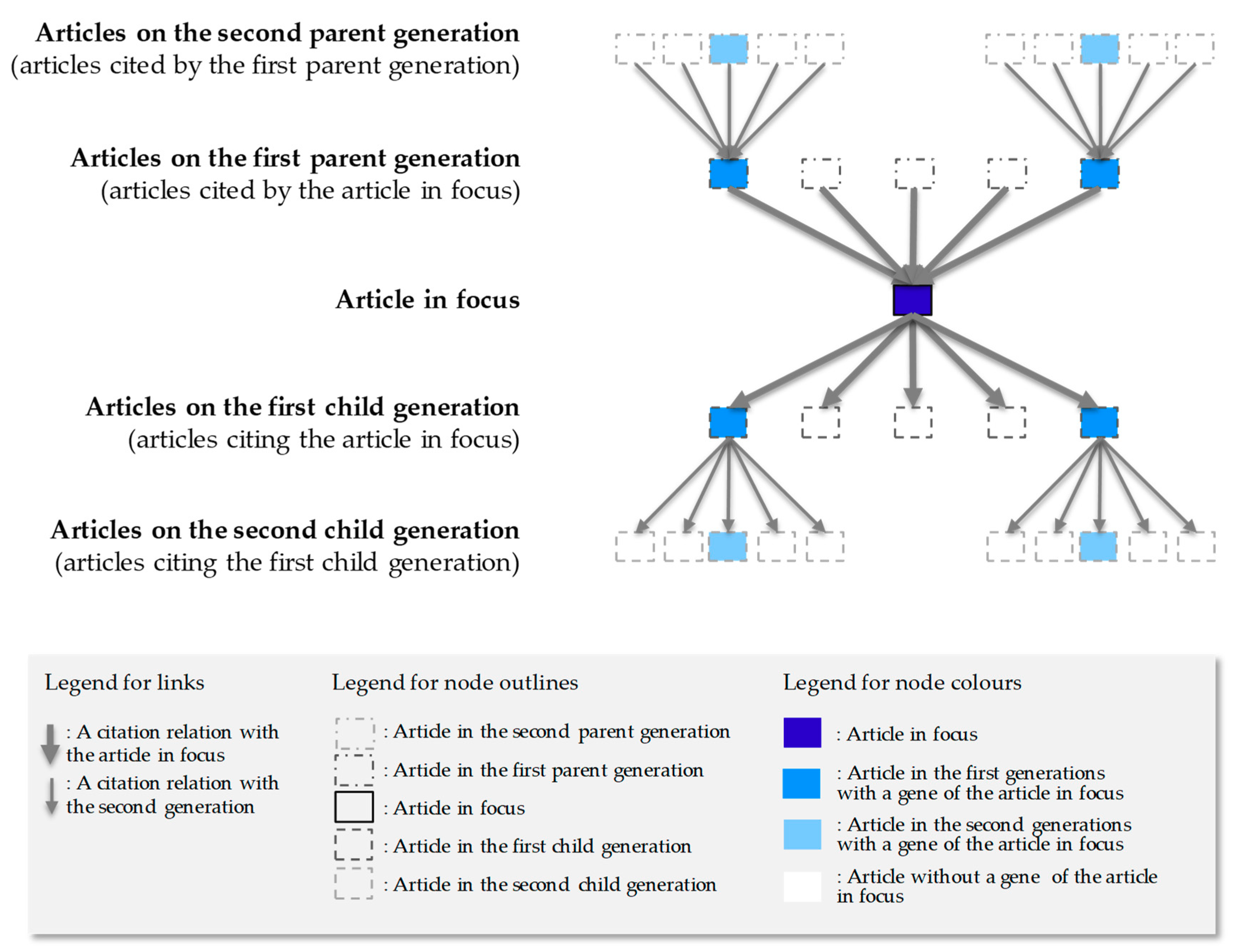
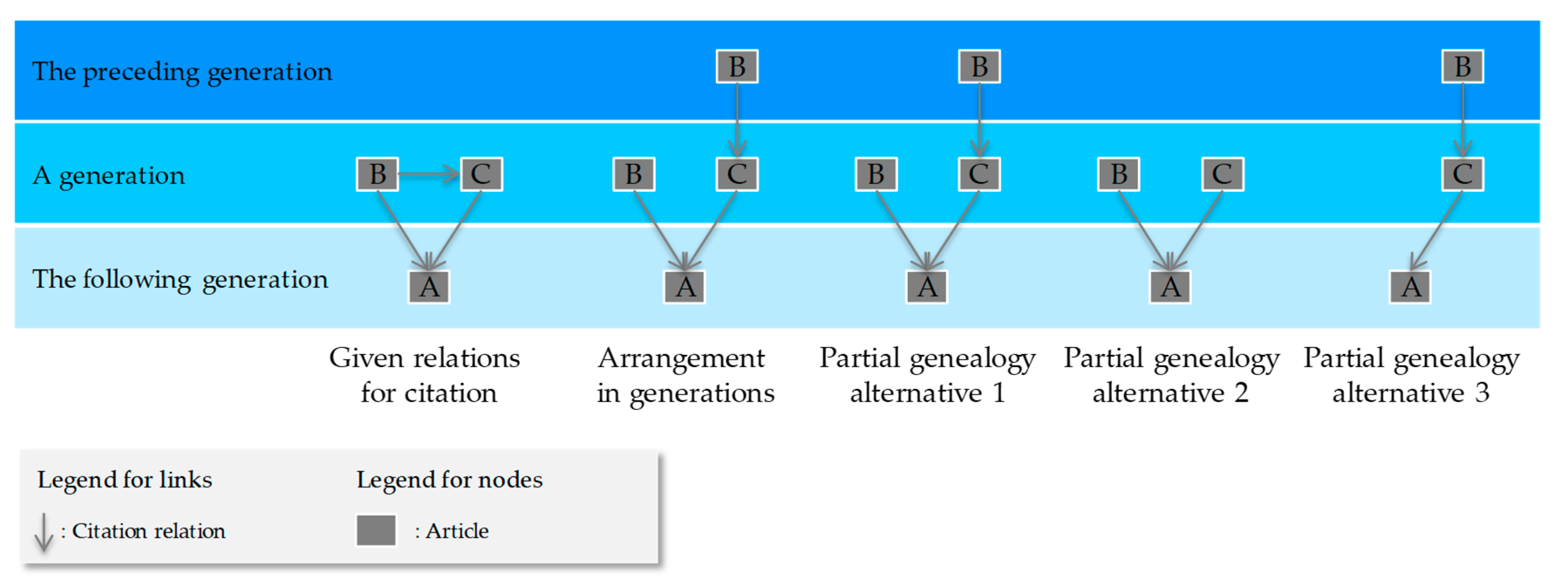


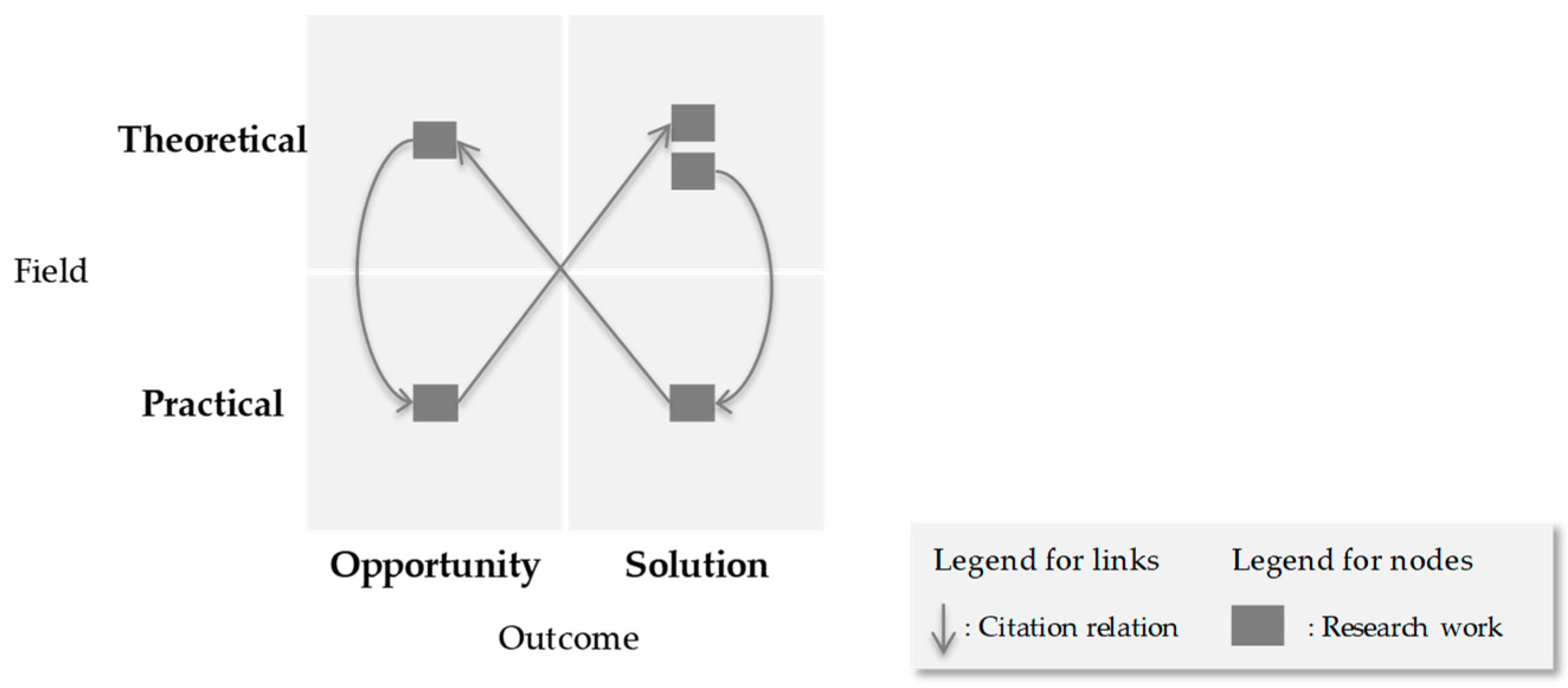
| Genealogy of Ref. [21] | Investigated for Ref. [21] | Genealogy of Ref. [32] | Investigated for Ref. [32] | |
|---|---|---|---|---|
| The Second Parent Generation | 0 | 8 | 0 | 28 |
| The First Parent Generation | 2 | 13 | 2 | 13 |
| The First Child Generation | 4 | 97 | 12 | 139 |
| The Second Child Generation | 5 | 95 | 2 | 126 |
| Indicator | Genealogy of PSS Design Research [21] | Genealogy of robust Design Research [32] |
|---|---|---|
| Frequency of Research in a Practical Field | 58 | 0 |
| Frequency of TD-1 Research | 33 | 0 |
| Frequency of Single Disciplinary Research | 0 | 100 |
| Frequency of a Solution Provided | 83 | 100 |
| Probability to Switch Fields | 55 | 0 |
© 2019 by the author. Licensee MDPI, Basel, Switzerland. This article is an open access article distributed under the terms and conditions of the Creative Commons Attribution (CC BY) license (http://creativecommons.org/licenses/by/4.0/).
Share and Cite
Sakao, T. Research Series Review for Transdisciplinarity Assessment—Validation with Sustainable Consumption and Production Research. Sustainability 2019, 11, 5250. https://doi.org/10.3390/su11195250
Sakao T. Research Series Review for Transdisciplinarity Assessment—Validation with Sustainable Consumption and Production Research. Sustainability. 2019; 11(19):5250. https://doi.org/10.3390/su11195250
Chicago/Turabian StyleSakao, Tomohiko. 2019. "Research Series Review for Transdisciplinarity Assessment—Validation with Sustainable Consumption and Production Research" Sustainability 11, no. 19: 5250. https://doi.org/10.3390/su11195250
APA StyleSakao, T. (2019). Research Series Review for Transdisciplinarity Assessment—Validation with Sustainable Consumption and Production Research. Sustainability, 11(19), 5250. https://doi.org/10.3390/su11195250




